Magee Clegg, founder and CEO of Cleartail Marketing, was approached by a client who was struggling with low site traffic and lead conversion rates. So, they conducted a customer journey map, which included every customer touchpoint from the first interaction to the last purchase decision.
The journey map revealed some key insights. Magee told me:
“We found that most visitors exited the website after viewing the product page, indicating a lack of clarity or compelling call-to-action. We also discovered that leads who were contacted within 48 hours were more likely to convert than those who were not.”
Based on this, they improved their page content, introduced a clear CTA, and implemented a timely follow-up process for leads. In fact, the insights gained from the customer journey map resulted in a 278% increase in revenue in 12 months.
But while they increased their client’s revenue, Magee would do one thing differently. He said:
“One thing we’d do differently is to integrate more data sources. While we used Google Analytics to gather most of our data back then, now we would also incorporate data from CRM systems, email marketing platforms, and customer feedback to get a more comprehensive understanding of the customer journey.”
Author’s note: You can use EngageBay CRM to gather this comprehensive data. You can track and analyze customer interactions across the marketing, sales, and service functions. This includes website behavior, email/SMS engagement, lead management activities, support tickets, and more.
In this post, we’ll look at five customer journey mapping examples you can find as inspiration for your journey map.
Table of Contents
What Is Customer Journey Mapping?
Customer journey mapping is the process of creating a visual artifact that captures the steps a customer goes through, their thoughts, emotions, actions, and touchpoints with a company (or companies) as they try to accomplish a particular goal. It provides a narrative view of the entire experience from the customer’s perspective.
The key aspects of a customer journey map are:
- It represents a single person or persona who typifies a key customer segment or archetype.
- It focuses on mapping the journey as that persona attempts to achieve a specific goal.
- It visually depicts the steps the customer takes, including interactions with the company but also other parties like friends/family, competitors, or independent activities like research.
- It aims to document the customer’s mindset – what they are thinking and feeling – at each stage of the journey.
- The core purpose is to “walk in the customer’s shoes” and see the entire experience through their eyes.
While additional elements like processes, systems, and employees that support the journey can be added, the foundation first maps the customer’s journey from their perspective as they pursue a particular outcome.
Elements of a Customer Journey Map
Here are the key elements of a customer journey map.
Customer persona
The customer persona represents the type of customer for whom you are mapping the journey. It is a semi-fictional character that embodies an important customer segment’s key characteristics, goals, behaviors, and pain points. Using a persona helps make the journey more concrete and human-centric rather than mapping for an abstract, general customer.
Touchpoints
Touchpoints are any customer interactions with your brand, product, or service during their journey. This includes human interactions like sales calls or website visits, mobile app usage, email, customer support, and social media engagement. Mapping all the touchpoints shows you the full spectrum of brand interactions along the way.
Channels
The channels refer to the different platforms where touchpoints occur. Common channels include physical locations/stores, customer support, websites, mobile apps, email, or social media. Mapping the channels gives you a view into the various contexts the customer moves through.
Emotions
Capturing the customer’s emotional state at key points is critical for empathy and understanding the subjective experience. Emotions like frustration, delight, confusion, or indifference can make or break a journey. Mapping emotions allows you to identify pain points and peaks of positive/negative sentiment.
Opportunities and pain points
Pain points are the struggles, problems, frustrations, and friction the customer encounters throughout the journey. They indicate areas of struggle that need to be improved. The pain points and emotion mapping allow you to identify key opportunities to enhance and optimize the journey. This could include new touchpoint experiences to add, processes to enhance, policies to change, or areas to reduce effort and friction.
The combination of these elements provides a rich view into the comprehensive experience of your customers as they try to achieve their goals with your product.
Related blog: 11 Affordable, Powerful Customer Journey Mapping Tools
Customer Journey Mapping Examples To Learn From
Here are customer journey map examples from which you can draw inspiration.
1. Rewind
Rewind, a SaaS company, had acquired another company, BackHub, which had a product for backing up GitHub code repositories. Despite expectations of a big sales increase, their revenue did not meet targets after the acquisition.
To understand the disconnect, Rewind partnered with Content Lift to conduct customer journey mapping through investigative interviews with existing customers.
They followed the following key steps:
- Defined the ideal customer profile and set clear research objectives around understanding the full buying journey before purchase.
- Created a discussion guide focusing on topics aligned with the hypothesized buying journey stages, not just a list of questions.
- Conducted 30-minute recorded video interviews with customers, allowing organic discussions to extract detailed insights.
- Analyzed recordings/transcripts to codify answers into buckets like triggers, research process, pain points, priorities, and evaluation criteria.
- Synthesized findings into a comprehensive buying journey map and report detailing the average purchase story for Rewind’s GitHub app.
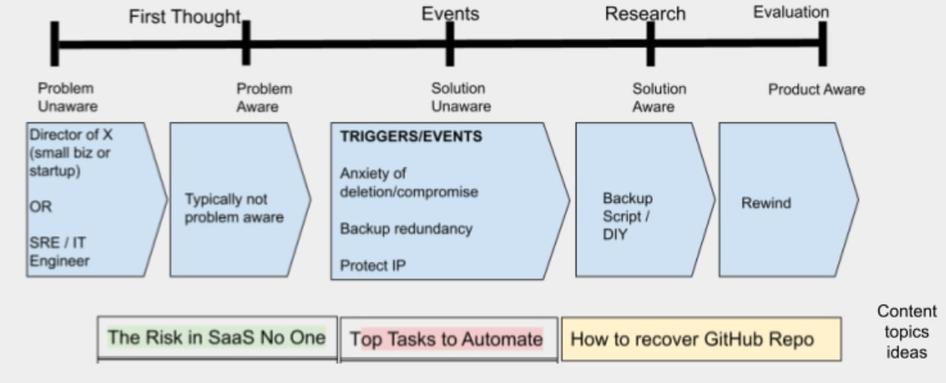
A major discovery was that Rewind had been targeting the wrong buyer persona. The research uncovered the actual persona and their buying motivations/process.
Using these insights, Rewind was able to revamp multiple areas:
- Created a new data-backed buyer persona
- Updated messaging across websites, marketing, sales enablement
- Developed a new content marketing strategy aligned with the real journey
- Refined product listings and paid marketing campaigns
This led to an immediate uptick in product installs and paved the way for more effective marketing tailored to the true customer journey. Rewind realized the value of firsthand customer research for marketing success.
2. Common App
Common App makes it easier for students to submit applications to multiple colleges.
3Pillar Global conducted student interviews before building the app to understand its audience. They worked with the product management team to carry out these interviews. The insights from this exercise would help them develop the app and understand the student journey through this important time of their lives.
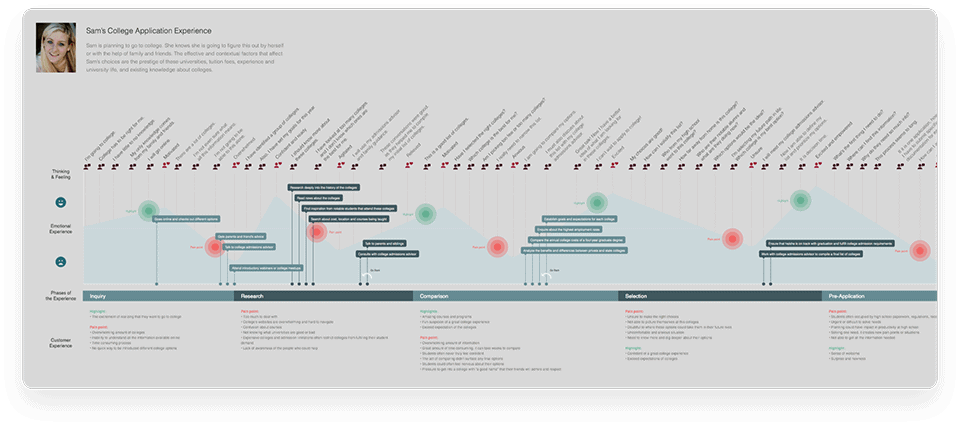
The journey is broken down into several key customer journey stages: Discovery, College Search, Application, Decision, and Pre-Orientation. For each stage, the map outlines the specific steps or touchpoints the student encounters, such as browsing college websites, attending campus tours, filling out applications, awaiting decisions, and preparing for enrollment.
Additionally, the map captures the emotions and sentiments the student may experience at different points in the journey, using green circles to represent positive emotions like excitement or relief and red circles to signify negative emotions such as stress, anxiety, or frustration.
Underneath each stage, the map provides additional context and insights sourced from the student interviews. This includes details on the student’s mindset, actions, pain points, and opportunities for improvement during that particular phase of the application process.
3. Carnegie Mellon University
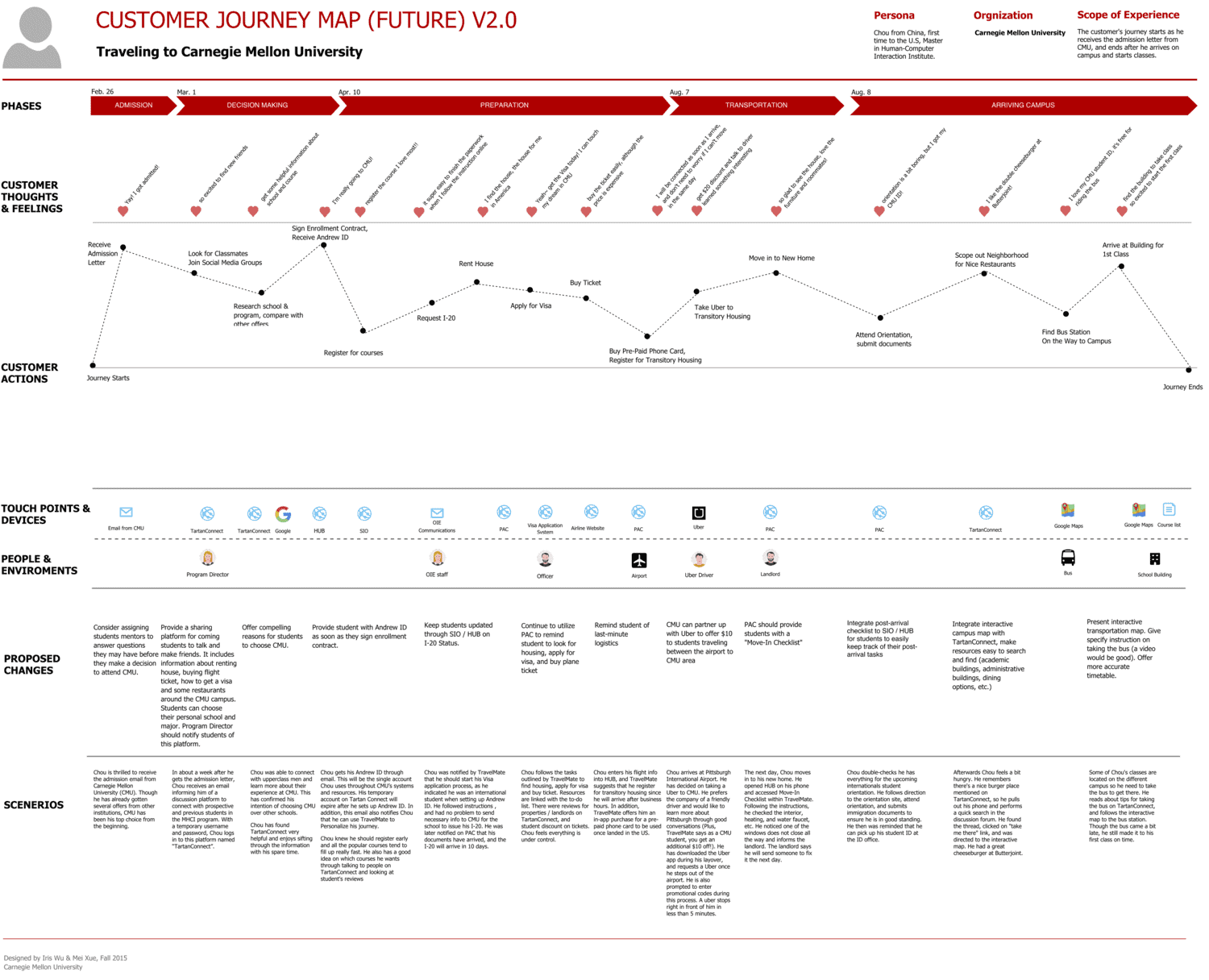
This image presents a detailed customer journey map for a prospective student traveling to and attending Carnegie Mellon University. The map covers the end-to-end experience from the admission phase through arriving on campus.
The journey is divided into distinct customer journey stages: Admission, Decision Making, Preparation, Transportation, and Arriving Campus. Within each phase, the map captures the customer’s thoughts and emotions represented by heart emojis.
It also visualizes the specific customer actions and touchpoints encountered at each step, such as reviewing admission letters, signing enrollment contracts, booking travel arrangements, moving into housing, and finding their way around campus.
The touchpoints span various channels and devices like websites, email, phone, in-person interactions, and mobile apps, which are depicted through icons below the journey stages. Additionally, it shows the people, environments, and university personnel involved, such as parents, travel providers, housing staff, and campus advisors.
A notable aspect is the “Proposed Changes” section that highlights potential improvements based on the mapped journey, such as providing a moving checklist, offering roommate matchmaking, integrating mobile check-in, and enhancing the campus navigation experience.
Here are some key takeaways from this customer journey map:
- Map the complete customer journey map, from initial engagement through ongoing customer lifecycle stages. This holistic view identifies gaps and opportunities across the full experience.
- Visually plot out each interaction across different channels like websites, apps, in-person, email, phone, etc.
- Map out the key stakeholders, personnel, environments, and external parties involved behind the scenes in delivering the experience. This surfaces ownership and collaboration opportunities.
4. ElderCare customer journey map
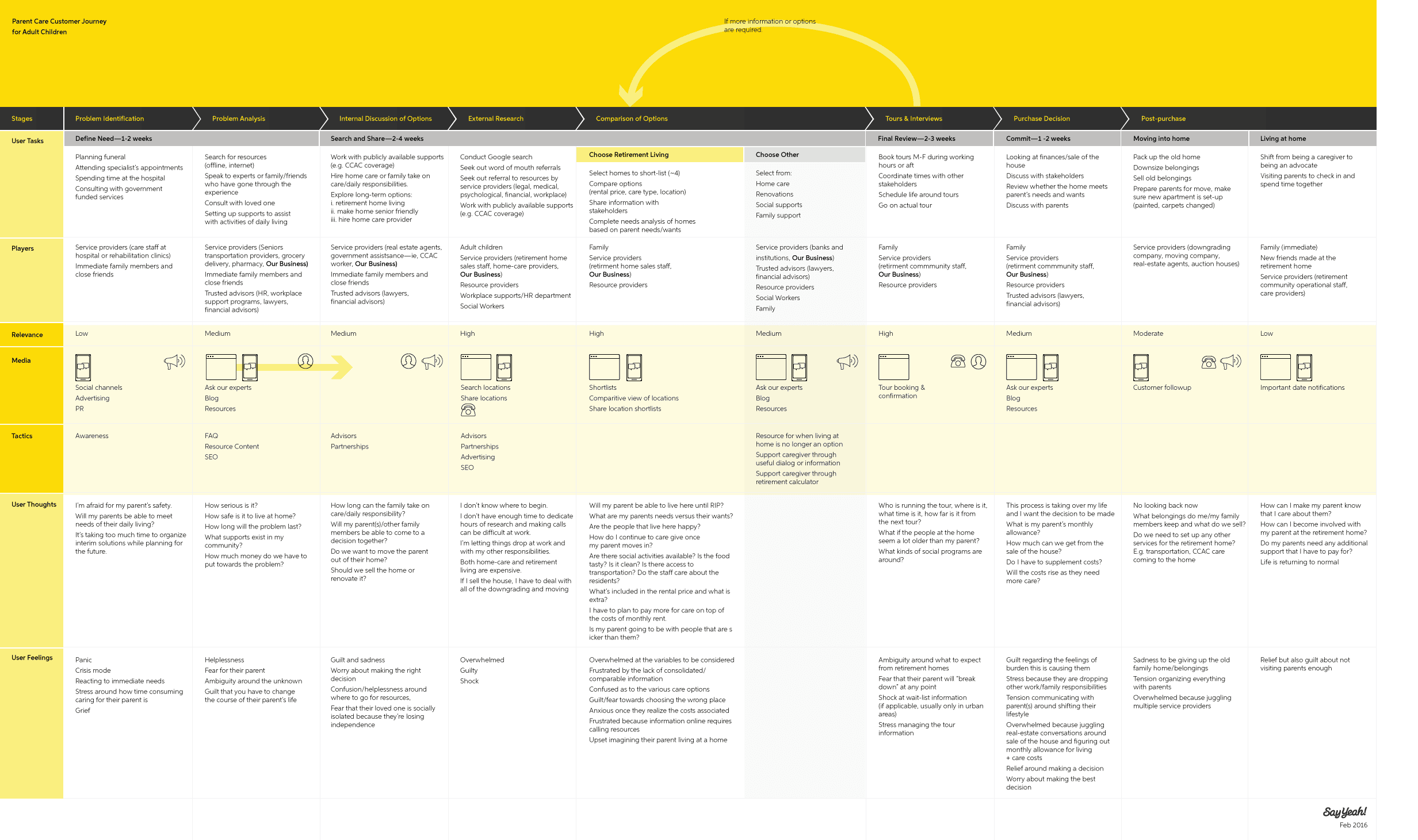
This image shows a comprehensive customer journey map for adult children seeking support for their ailing/aging parents. SayYeah arrived at this persona because an adult child was viewed as the decision maker when choosing a retirement home.
The sole purpose of this journey mapping process was to uncover possible opportunities to capture market share in the elder care industry.
The journey is divided into distinct customer journey stages: Problem Identification, Problem Analysis, Internal Discussion of Options, External Research, Comparison of Options, Tours & Interviews, Purchase Decision, and Post-Purchase. This sequential flow provides clarity into the full decision-making process.
At each stage, the map captures the specific user goals, actions they might take (like searching online or consulting providers), the people/parties they may interact with (family, providers, online resources), and the channels/touchpoints used (website, advertising, in-person, etc.). This level of detail is crucial for understanding all touchpoints.
Additionally, the map incorporates the user’s thoughts, questions, and emotional state through call-out sections.
At the end, this journey mapping process uncovered a number of options customers have apart from retirement home:
- Home care
- Renovating their homes to make them suitable for their elderly parents
- Support from family members and social support
So it became clear there are three ways they can capture the market share apart from having retirement homes.
5. Online grocery store customer journey map

A key strength of this journey map is how it ties the customer experience directly to business goals and KPIs at each stage. For example, in the Awareness stage, the business goal is to increase awareness and interest, with a KPI of the number of people reached.
This connection to measurable metrics and the responsible teams continues through subsequent stages like increasing website visitors, online cart value, conversion rates, customer satisfaction scores, and finally retention rates and advocacy in the final Loyalty stage.
Additionally, the bottom section maps the organizational activities and responsible roles/departments that are aligned to enable that customer experience. This allows the entire organization to see how their functions fit into delivering a cohesive end-to-end journey.
Read also: Understanding Customer Journeys in Marketing Automation
Steps to Map the Customer Journey
We’ll break down the journey-making process into manageable steps. I hope this will provide the right guidance and help you understand how to use this in your organization.
Here are the steps to creating a customer journey map.
Define the scope and purpose of the map
Think of customer journey maps in terms of use cases and audiences. This will ultimately help you define the purpose of the map. Joana de Quintanilha, VP and principal analyst at Forrester, adds:
“…So I need to understand what the use case is. Who the audience for that journey map is, because that then determines the types of exercises I’m going to do. It determines what information goes into the journey map, and it sets the scope for what it is that I’m trying to do in this particular instance.”
Explicitly stating the primary use case for the map will guide its creation and the level of detail needed. Common use cases include:
- Gaining executive buy-in/alignment on customer experience initiatives
- Modeling and envisioning an optimized future-state journey
- Identifying current pain points and areas for improvement
- Breaking down organizational silos by aligning journey ownership
- Employee training/onboarding to build customer empathy
Just as importantly, you need to identify who the core audience will be for reviewing and applying the journey map. This could include:
- Executive leadership
- Cross-functional teams involved in delivering the experience
- Customer experience/service professionals
- Employee training groups
- Outside partners/vendors
Knowing the audience will shape how the journey is visualized and what supplementary information is included.
Identify customer personas
A persona represents a key customer segment with shared behaviors, goals, pain points, and traits.
If you don’t already have robust personas developed, this may require some upfront research or workshops. However, even basic product or marketing personas can serve as a starting point that can be enhanced.
When selecting the persona(s), consider:
- Number of personas: Will you be mapping the journey for a single primary persona? Or do you need to create separate maps for multiple distinct personas if their journeys differ significantly?
- Persona priorities: If mapping multiple personas, prioritize the most valuable or prevalent customer segments first. You can always expand to additional personas later.
- Journey segmentation: Determine if you will be mapping the entire end-to-end journey for each persona, or if you’ll segment it into key phases or sub-journeys to map.
The personas you select should align with the high-priority customer segments that are most relevant for the stated purpose and use case you previously defined for the journey mapping initiative.
Map out touchpoints and channels
The next step is to map out all the touchpoints and channels where the customer interacts with your brand throughout their journey. Touchpoints are any point of interaction, while channels refer to the medium or environment.
Start by documenting each touchpoint sequentially as the persona moves through the journey. Touchpoints can include:
- Digital interactions (website, mobile app, email, chat, social media)
- Physical locations (stores, branches, sales offices)
- Human interactions (sales calls, support conversations, in-person meetings)
- Operational touchpoints (packages, invoices, payments)
- Third-party touchpoints (online reviews, partner websites)
For each touchpoint, identify the corresponding channel it occurs in, such as:
- Owned digital properties (website, app, email)
- Call center/support channels
- Physical spaces (retail, corporate offices)
- Partner integration points
- Online/Offline Media (ads, events)
Mapping touchpoints by channel gives you a multi-dimensional view of the experience across different environments.
EngageBay can help you capture this complete customer journey. It allows you to visualize the entire path a customer takes, including all interactions across different modules like:
- Website behavior tracking
- Email/SMS communications
- Support tickets
- Phone call logs
- Social media engagement
The contacts tab provides customer touchpoints, automatically pulled in from your different engagement channels in EngageBay.
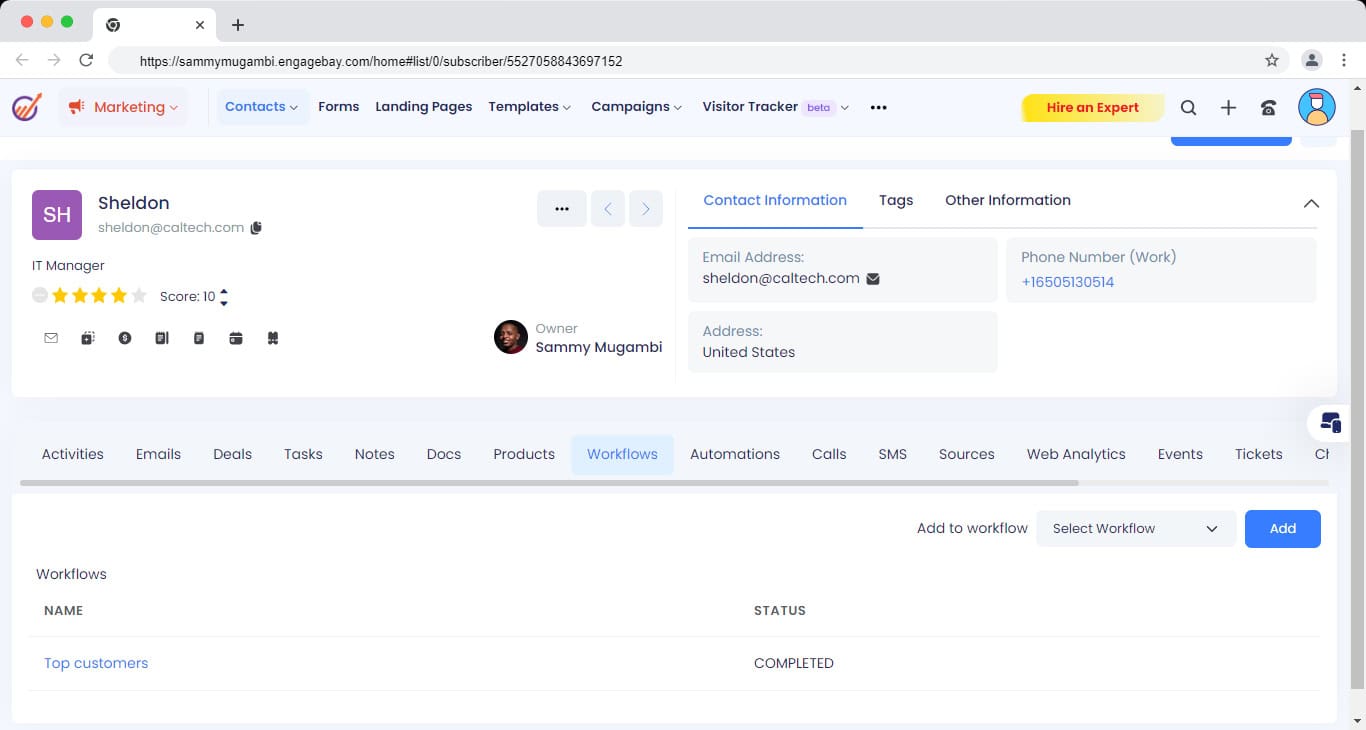
Related blog: A Guide to Capturing, Analyzing, and Using Customer Data Insights
Analyze customer emotions, pain points, and opportunities for improvement
Document how the persona is feeling throughout each touchpoint. Are they frustrated, confused, delighted, or indifferent? Understanding their emotional state unveils powerful motivations and barriers.
Similarly, note any pain points or friction the persona encounters during interactions. This could include roadblocks, inefficiencies, inconsistencies, or areas of high effort required by the customer.
You can use customer interviews or voice of customer data to identify these pain points and customer emotions. Additionally, using session recording tools and other customer segmentation tools can reveal how customers truly navigate your websites/apps and where they struggle.
Share and iterate the map with stakeholders
Once you have an initial draft of the customer journey map, it’s critical to share it with relevant stakeholders across the organization and gather feedback to refine and validate it. Here are a few key considerations:
- Identify core stakeholders: Determine who the key stakeholders are that need to be involved upfront in reviewing and providing input on the journey map. This should include cross-functional representatives from all teams involved in delivering the end-to-end experience you mapped.
- Balance stakeholder involvement: The number of stakeholders to involve initially will depend on the purpose and time constraints of the mapping exercise:
- For broad organizational education, you may want to involve a wider range of stakeholders from the start.
- For time-sensitive initiatives, start with a smaller core group to keep the process focused.
- Leverage workshops: Use the map to walk stakeholders through the current experience, discuss perceived pain points, and ideate on potential solutions.
- Expand stakeholder involvement: If initial reviews involve a smaller group, find ways to expand stakeholder involvement over time through broader presentations, feedback exercises, surveys, and more.
The key is striking the right balance – enough stakeholders to get comprehensive perspectives, but not so many that it becomes an unmanageable process.
Read also: Omnichannel Customer Journey: A Beginner’s Guide
Conclusion
Creating a comprehensive customer journey map is crucial for understanding the customer experience and identifying areas for improvement. The examples showcased from companies like Rewind, Common App, Carnegie Mellon University, and others demonstrate this.
You can gain valuable insights into the customer experience by mapping out touchpoints and channels, analyzing customer emotions, and iterating the map with relevant stakeholders.
EngageBay can help you capture and analyze these customer interactions across various channels, allowing you to gain a deeper understanding of the customer journey.
